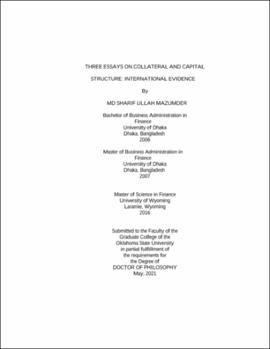| dc.description.abstract | This dissertation comprises with three chapters. In first chapter, I investigate a novel feature of collateral: its role as a commitment device that induces a speedier adjustment of leverage to the optimal ratio. As a manifestation of commitment, firms increase the speed of adjustment of book leverage ratio (to the optimal) by 3.0% if they possess higher tangible assets. This commitment value of tangible assets is more important if the adjustment is expensive, and the monitoring from creditors is costly. I find that firms with higher tangible assets adjust leverage more speedily than those with lower tangible assets even if they are over-levered, headquartered in weak creditor rights countries, or both. Further, firms with financial flexibility (spare debt capacity) and higher tangible assets invest more by issuing new debt. In the second chapter, I document that social trust is an important country-level factor of capital structure choice using firm-level data from 32 countries (excluding the U.S.), Specifically, higher social trust is associated positively with long-term debt ratio. The findings are robust when I control for other important country-level and firm-level factors. In particular, the association becomes stronger when governance quality, creditors' rights, and the financial development of a country are weak. I also analyze firm-level factors such as tangible assets, profitability, growth opportunity, and financial distress, with their interaction effect on leverage ratio. Factors that hinder (ease) the use of external financing produce a stronger (weaker) association between social trust and the long-term debt ratio. Existing studies of the capital structure show a positive association between tangible assets and leverage, but studies have ignored the potential variation in magnitude due to the institutional heterogeneity across countries. In chapter three, I find that the association between tangible assets and leverage is weaker if firms are located in countries with stronger creditors' rights, better financial development, good governance, and more transparent countries. The robustness tests of the association between asset tangibility and leverage reveal that the association is stronger during a crisis period. However, this crisis-period association becomes less positive if firms headquartered in stronger institutional environments, i.e., stronger creditors rights, better financial development, good governance, and high country-level transparency. | |
